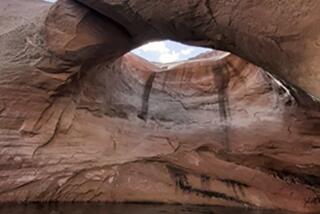Bandelier Park’s Old Ruins Fall Prey to Time, Weather--and People
- Share via
BANDELIER NATIONAL MONUMENT, N. M. — Caves were a cinch to carve in the soft volcanic-ash face of Bandelier, meaning these centuries-old Indian ruins are just as easily erased by fire and erosion.
“The erosion itself is starting to threaten some of the ruins in the back country, and that is unacceptable,” said Roy Weaver, superintendent of Bandelier National Monument, the park in the Jemez Mountains 45 miles west of Santa Fe.
The park boasts 3,000 to 5,000 archeological sites dating from 1100 to 1760, including remnants of three-story pueblos that had as many as 400 rooms. But time, weather and the effects of man’s encroachment are slowly eating away at Bandelier’s building blocks.
Outside the visitors center in Frijoles Canyon are the ruins of a village called Tyuonyi, an ellipse of dwellings around a central religious chamber, or kiva, into which people descended by ladder.
Tourists may stroll through Tyuonyi on an asphalt path and peer down into the excavated kiva. They also may visit dwellings carved into the soft volcanic ash, or tuff, on the north wall of Frijoles Canyon.
“With primitive tools--like a good, hard oak stick--you could literally hack yourself a cave into the walls,” said Bob Powers, a National Park Service archeologist who is heading a study of Bandelier.
Ladders are provided for visitors to climb into some caves. One series of ladders leads to a restored kiva cut 140 feet high in the cliff’s face. Visitors may enter the kiva.
Last year, 322,000 people wandered through, Weaver said.
In contrast, Frijoles Canyon had a population of probably no more than 700 people at its peak, around 1300 to 1550, Powers said. Around 1550, Tyuonyi was abandoned. The reasons remain unclear.
“My gut feeling is that a combination of overhunting, overuse of natural resources, a growing population and a lot of competition from other pueblos throughout the Rio Grande Valley may have made the area not very viable economically,” Powers said.
Cochiti Pueblo, still flourishing nearby, is believed to have evolved from this settlement. A Cochiti Indian first led Swiss-born anthropologist Adolf Bandelier into cave-studded Frijoles Canyon in 1880, who called it “the grandest thing I ever saw.”
His 150th birthday, Aug. 6, was celebrated this summer at the park, which will be 75 years old in February.
Powers’ crews completed their fourth year of field work here in August and return in the spring for their final year. Their findings have yet to be analyzed.
“Our major focus is to try to figure out why the big pueblos that appear in the early 1300s, why those were built,” said Powers. “Why did they all move in together in these big communal pueblos?”
That was a major change in their cultural habits, he said.
“One factor almost certainly is a growing population,” he said. “As population increases, there are not as many resources.”
The crews have been mapping the thousands of caves and other ruins that dot the monument’s 32,737 acres, trying to stay ahead of the erosion that periodically sheers off pieces of the cliff.
“We have two kinds of erosion. One is visitor-induced. The other is based on previous land-management abuses,” he said. “This goes back over 100 years. Because of the overgrazing and the elimination of fire, the natural grasses which were quite extensive at the time have been eliminated.”
In 1977, a fire burned through ruins on nearby Escobas Mesa. The intense heat and firefighting efforts that included heavy equipment turned much of the ruins into dust, said Judy Miles, field director for the archeological study.
Those ruins, like Tyuonyi and the other ancient villages of Bandelier, had been made of bricks of tuff, Powers and Miles said.
The tuff was created by two series of cataclysmic eruptions 1.4 million and 1.1 million years ago that formed the nearby Valles Caldera. Tuff is a mixture of frothy glass bubbles, glass shards, crystal fragments and bits of rock, said Wolf Elston, a geologist at the University of New Mexico. Heat bursts the bubbles, he said.
More to Read
Sign up for The Wild
We’ll help you find the best places to hike, bike and run, as well as the perfect silent spots for meditation and yoga.
You may occasionally receive promotional content from the Los Angeles Times.






